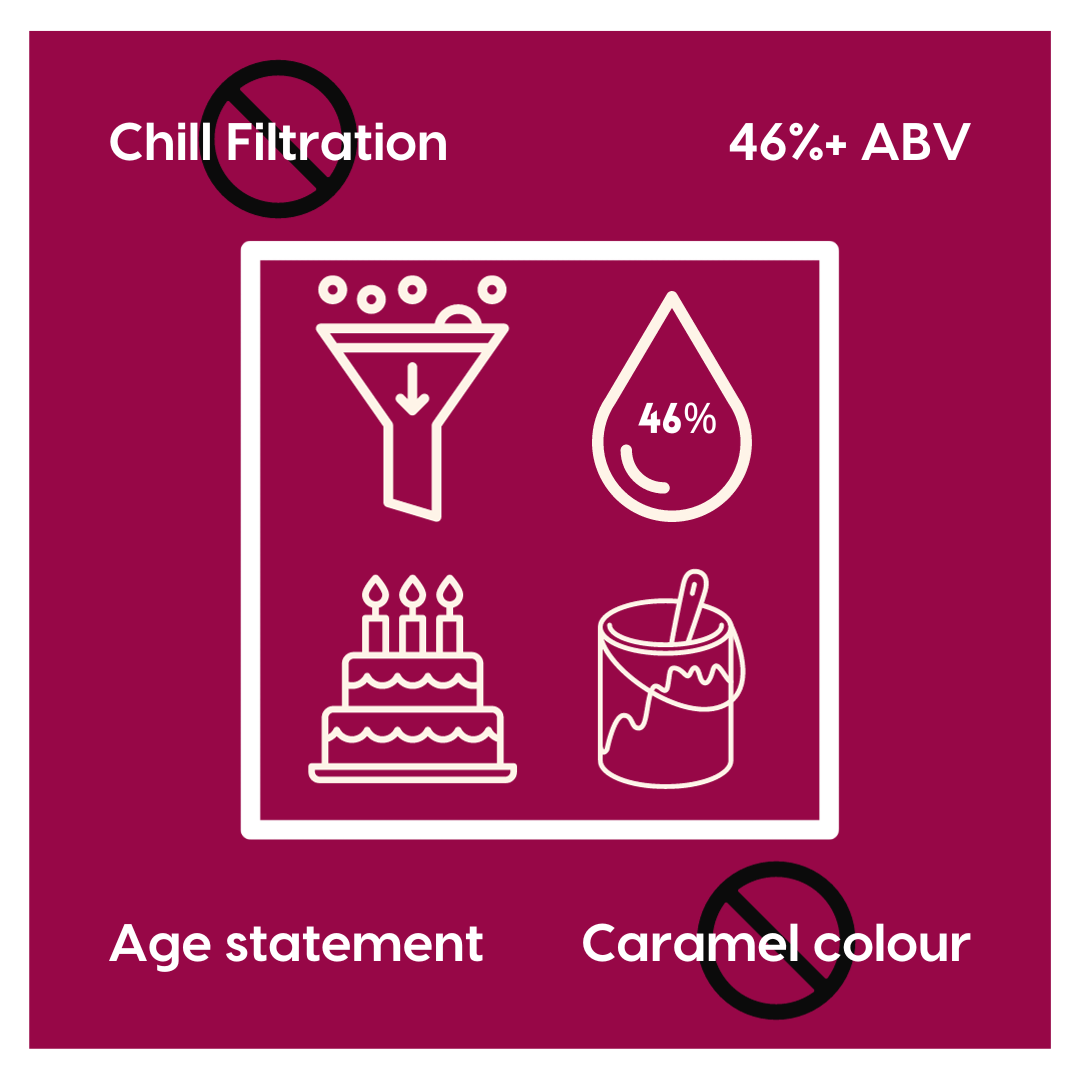Spend more than a few days looking at YouTube whisky videos and you inevitably run across the concept of integrity presented whisky. If you can’t exactly get your head around the concept, or rather why the concept is there, stick with me. I was there and it took me a minute to get it. If you are familiar with the concept and the reasons behind it, please feel free to skip this post. You are clearly further ahead in your journey than I was at this stage of mine.
This is a concept that will be referred to and will be more and more moving forward. For this reason, I want to make sure to introduce the concept to anyone new-ish to whisky or not exposed to whisky geeks (no offence meant, quite the contrary).

Integrity presented whisky: the basics
The concept of integrity whisky is easy to state and summarised in the image above. No caramel added, no chill-filtration, 46%+ abv and an age statement.
I am unsure when this concept started. The first reference which people often point to is this video posted 4 years ago by Ralfy.com. Did he come up with integrity-presented whisky or is he the one who evangelised us unwashed (in new make) masses? Does it really matter? One way or another the concept of integrity presented bottles has gone viral. I certainly thank Ralfy for kicking things off.
Now, you could stop at the 4 key concepts and leave it at that. But why would you? I am a born sceptic, so I never accept something as is without at least attempting to try and understand why.
I will, at some point dive deeply into each side of integrity whisky. Today I will stick to the key thinking behind each of the 4 tenets of integrity whisky and their motivation:
No caramel colour
Single malt whisky is a batch-made product with variability between different production runs – colouring is one way to make a product look more uniform, which can be seen as negative by some and positive by others. There is a less honest reason behind it potentially. Adding caramel can be a way of exploiting the incorrect perception that the darker the whisky the better and more valuable (and as a result pricier). For those who appreciate all the colour nuances whisky gains during cask ageing, it also unfortunately flattens the look of whiskies and hides the natural hue of the spirit. A integrity presented whisky should come with its natural colour
No chill filtration
Chill filtration is employed to remove part of the oils in the spirit which could become cloudy (the so called Scotch mist) when the spirit is mixed with water or ice, or, if below. 46%, even if exposed to lower temperatures. The issue with chill filtration is that, according to its detractors, it strips the whisky of some of its mouthfeel and taste for the sake of perception from uninformed consumers. Avoiding chill filtration provides integrity whiskies drinkers with a better experience.
46% abv
There are three reasons why 46% abv is seen as the minimum alcohol level for integrity bottling. The first is related to chill filtration. A 46% or higher whisky will remain clear and not get cloudy if cooled, hence its presentation remains clear and transparent with no signs of cloudiness when not chill-filtered.
The other reason, as important if not more, is flavour dilution. Whisky is diluted from its ageing cask strength to its final one with water. This does not dilute only the alcohol but also the flavour molecules. While 40% is the minimum allowed for single scotch malt, this is considered a level of dilution that compromises taste and mouthfeel. 46%+ abv is considered to deliver an overall better tasting experience.
Finally, it is about profits. When you take a cask strength whisky and dilute it to 40% instead of 46%, by adding more water, you end up with more product to sell and more profit. No one will argue about water, at least in Scotland, being cheaper than cask strength whisky. Producers who predominantly bottle at 40% are possibly putting profit before quality.
Age statement
We all learn very quickly that older whisky is more expensive. This reflects the cost of storage, the losses in volume due to evaporation and more. Scotch single malt has very strict rules on age statements which give consumers clear information. In the past few years, many distilleries have started bottling significant shares of their products as Non-Age Statement whiskies (NAS).
NAS prices vary greatly: while some are affordable entry-level bottles, just as many go for pretty substantial prices. The argument for integrity presented whiskies is that providing an age statement is a matter of transparency. Selling a 5-6 year old spirit as NAS but charging as if it was a 12 or 15-year-old bottle of the same strength might not be considered fair by many. This does not mean younger spirits do not at times deserve a high price, but it should be the customers’ right to make an informed choice.
I hope you now have some more details to understand the reasoning for integrity whisky. Ultimately it all boils down to providing consumers with honest drams that have not been neutered to appeal to the minimal common denominator of taste. While I admire the intention behind the concept, I see pros and cons to each of the four integrity points. That will require a dedicated and much longer post, but for another time… back to our usual program now. Salinte!